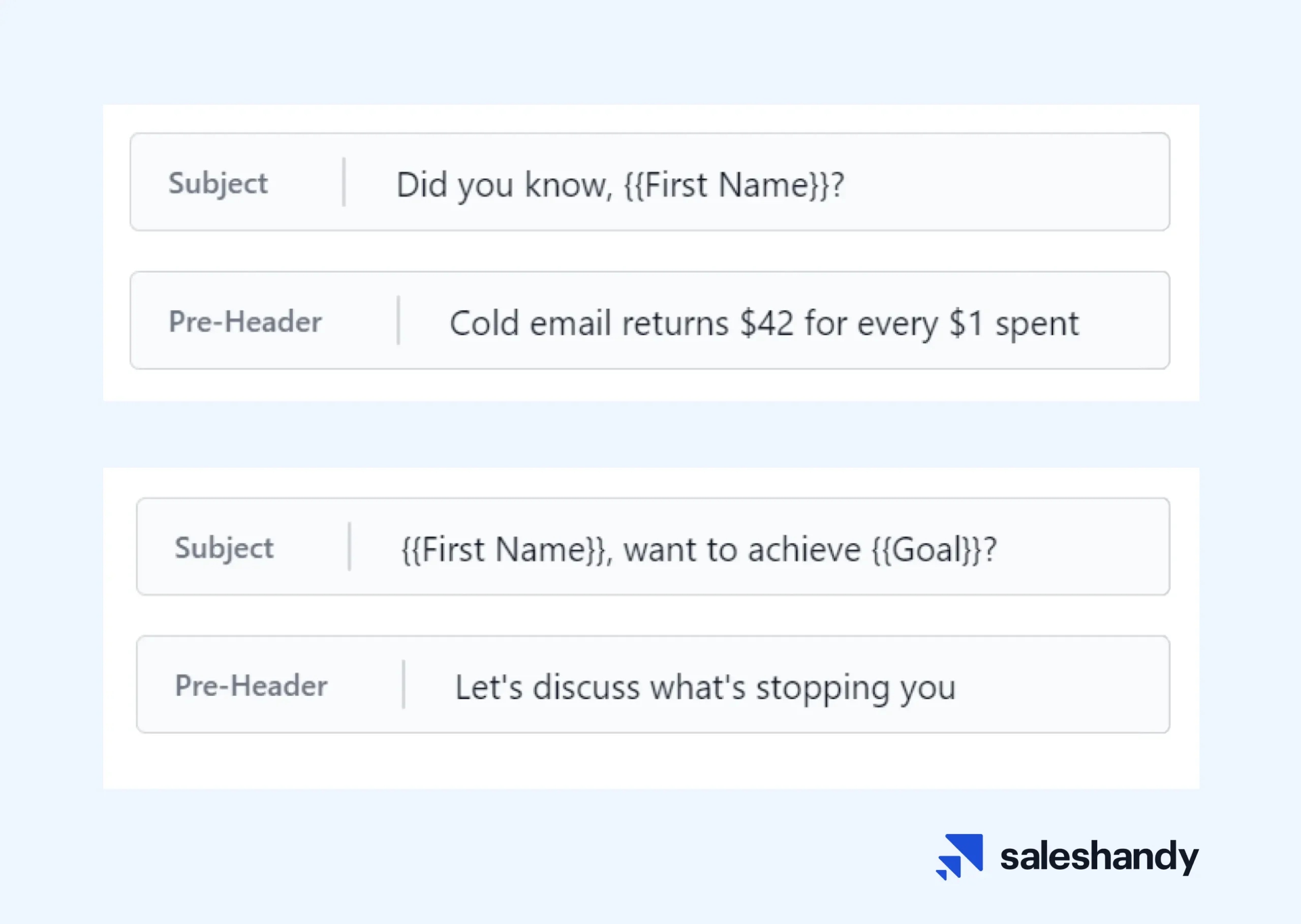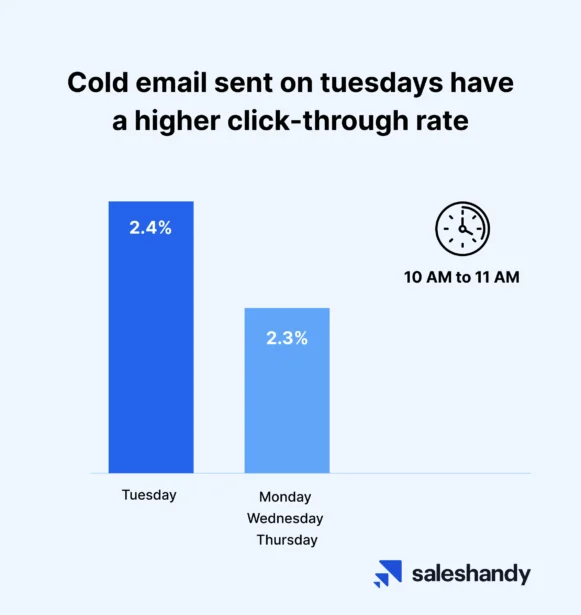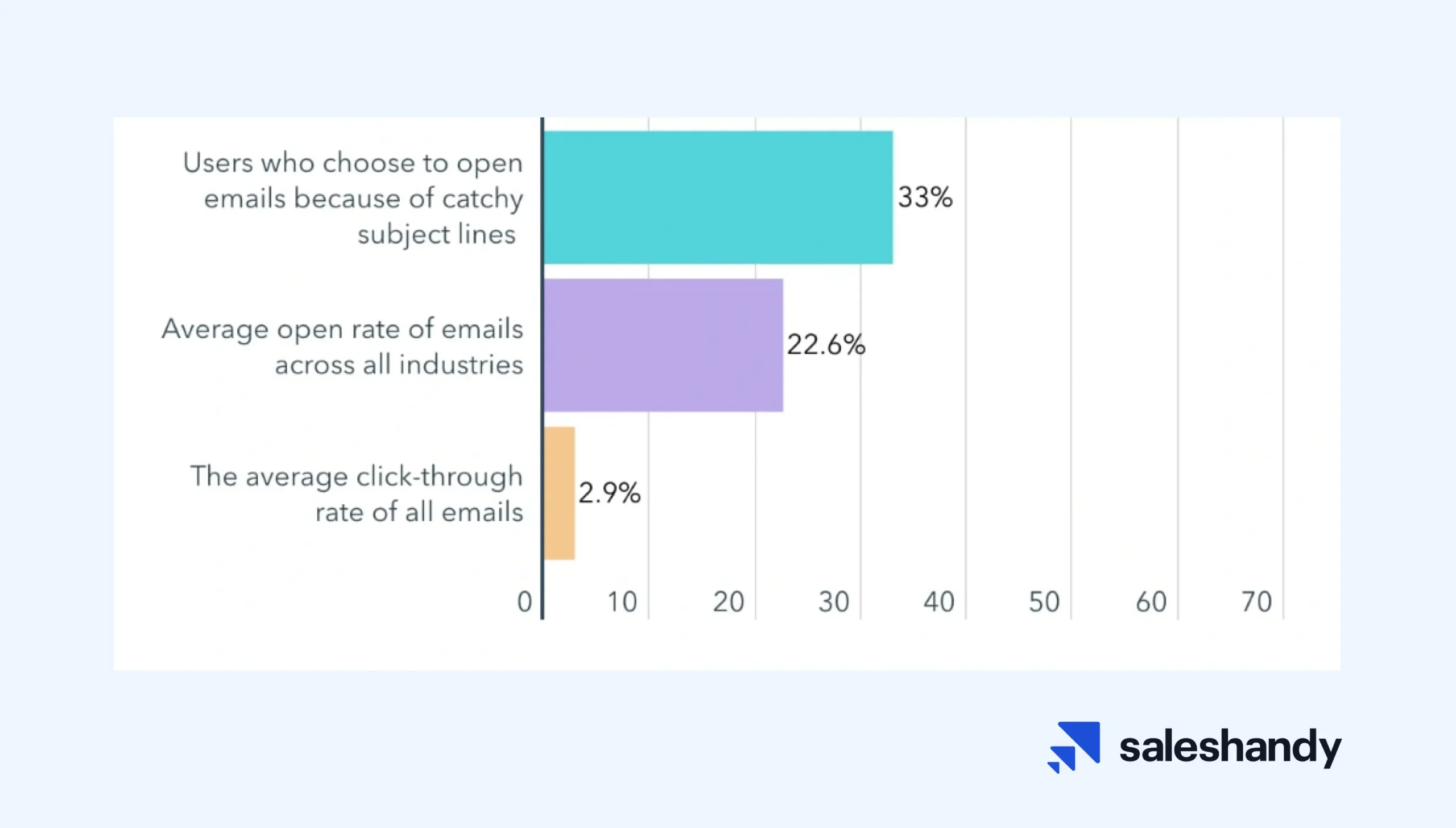Contents
- 1 Cold Email Statistics 2024 – Table of Contents
- 2 1. What is the Average Open Rate for Cold Emails?
- 3 2. What is the Average Response Rate for Cold Emails?
- 4 3. Can Follow-Up Emails Boost Your Response Rate?
- 5 4. What is the Average Unsubscribe Rate For Cold Email Campaigns?
- 6 5. Which is the Best Day to Send Cold Emails?
- 7 6. Do Subject Lines Affect Email Open Rates?
- 8 7. Does A/B Testing Work to Boost Open Rates in Cold Emails?
- 9 8. Does Cold Email Generate Good ROI?
- 10 9. How Long Should Your Cold Emails Be?
- 11 10. Should You Use Segmentation For Your Cold Email Campaigns?
- 12 11. How Does Your CTA Impact Email CTR?
- 13 12. Should You Use a Targeted Email List?
- 14 13. Should You Add Success Stories in Cold Emails?
- 15 14. Should You Add Limited Time Offers in Cold Emails?
- 16 15. Should You Add Hyperlinks in Your Cold Emails?
Do people even open cold emails in 2024?
Believe it or not, cold emails are still very effective.
But as we head towards 2024, it’s important to check the latest data and trends around cold email outreach to upgrade your strategy.
What response rates are achievable? How do subject lines affect email open rates? How many follow-up emails should you send?
We’ve answered these questions (and many more!) with the latest data in this blog.
Additionally, we’ve also shared pro-level tips to help you make the most of your cold email campaigns.
So, whether you’re looking to get started with cold email outreach or optimize your existing strategy, you must not miss reading this if you want to grow your cold email results.
Cold Email Statistics 2024 – Table of Contents
- What is the Average Open Rate for Cold Emails?
- What is the Average Response Rate for Cold Emails?
- Can Follow-Up Emails Boost Your Response Rate?
- What is the Average Unsubscribe Rate For Cold Email Campaigns?
- Which is the Best Day to Send Cold Emails?
- Do Subject Lines Affect Email Open Rates?
- Does A/B Testing Work to Boost Open Rates in Cold Emails?
- Does Cold Email Generate Good ROI?
- How Long Should Your Cold Emails Be?
- Should You Use Segmentation For Your Cold Email Campaigns?
- How Does Your CTA Impact Email CTR?
- Should You Use a Targeted Email List?
- Should You Add Success Stories in Cold Emails?
- Should You Add Limited Time Offers in Cold Emails?
- Should You Add Hyperlinks in Your Cold Emails?
1. What is the Average Open Rate for Cold Emails?
When it comes to cold emailing, open rates are a key metric. Achieving a high open rate means your audience is actually reading your cold emails.
It’s proof that your campaign is performing well. So, what’s the average open rate for cold emails?
The average open rate for cold emails is around 24%.
If you want to achieve a good open rate, know that timing is everything.
Think about it: When are people likely to open your cold emails?
You need to send your cold emails when they are available and likely to check their inbox.
It’s like knowing the perfect moment to drop your punchline at a party.
Sending your emails at the right time can seriously amp up your open rates. So, get into your data and analytics to find when your prospects are likely to open your cold emails.

And if you want a high open rate, here’s a special tip:
Add an engaging pre-header text.

Studies have shown that if you include an interesting preheader text, you can add a sweet 10% to your open rates.
Also Read: How to Get High Open Rates For Your Cold Emails
2. What is the Average Response Rate for Cold Emails?
Let’s get this straight: Sending cold emails won’t guarantee a response. This could be due to various reasons — people may be busy or simply not interested.
You don’t have to take it personally.
Just look at the numbers:
Only 8 out of 100 emails get a reply.
That means the average response rate is 8.5%.
Cold email success is about strategy, timing, and a bit of experimentation.
If you want to boost your response rates, adjust how often you send your cold emails.
For example, sending one email per week over the course of four weeks can increase your response rate by 20%.
Think of it like planting seeds and taking care of them patiently.
Additionally, keep a keen eye on response times.
Quick responses often indicate a higher level of interest.
3. Can Follow-Up Emails Boost Your Response Rate?
Sending that initial cold email is like knocking on a door, but sometimes, there’s no answer right away. That’s where follow-up emails come into play.
Sending at least three follow-up emails can increase the response rate by 28%.
But why are follow-ups such a big deal?
They help you nurture relationships, and catch your prospects’ attention when the timing is just right for your offering.

Pro Tip: If you follow up strategically every three days, then after seven days, and finally after 14 days, you can expect a mighty 40% higher response rate compared to following up only once every seven days.
4. What is the Average Unsubscribe Rate For Cold Email Campaigns?
Your unsubscribe rate is like a measure of how many of those people decide they don’t want to get any more emails from you.
If a lot of people are unsubscribing, it might mean that they’re not interested or they don’t like the emails you’re sending.
This is a sign that you might need to change something, like what you’re saying in the emails or who you’re sending them to.
The average unsubscribe rate is 0.17%
Out of every 1000 people who receive emails, about 1 or 2 of them, which is only 0.17%, might say, “I don’t want these emails anymore” and unsubscribe.
If you exceed this number, there’s still hope.
Anything below a 0.5% unsubscribe rate is considered good.
5. Which is the Best Day to Send Cold Emails?
Sending your cold emails on the right day increases the likelihood that recipients will open and read them.
If you send an email on a day when people are overwhelmed with messages or not checking their inboxes, your email may get lost.
So, when should you send cold emails?
Send your cold emails on Tuesdays for better click-through rates.

Research from reliable sources like HubSpot and GetResponse consistently shows that Tuesday is a great day to get more people to open and respond to your emails. It’s like shining a bright light on your emails to make sure they catch people’s attention.
Now, let’s go one step ahead.
Which are the best hours to send your cold emails?
Late mornings, specifically between 10 AM and 11 AM, in the recipient’s local time zone, tend to be the best times to send cold emails.
During this time, when professionals are starting their workday and enjoying their morning coffee, they are more open to engaging with emails.
But here’s an important tip: Avoid sending emails on Mondays and Fridays.
On Mondays, people often have lots of emails from the weekend to catch up on, making it tough for your message to stand out.
On Fridays, email engagement tends to drop as people get ready for the weekend.
However, this isn’t a set rule.
Think about the industry and the people you’re emailing. Different fields and professionals may have their own email habits.
So, studying your audience’s behavior can give you an edge in deciding the best time to send your cold emails.
6. Do Subject Lines Affect Email Open Rates?
Subject lines have a major impact on email open rates.
The subject line is like the first impression of your email, and it’s what recipients see before deciding whether to open the email or not.
An engaging, relevant, and well-crafted subject line can catch the recipient’s interest and encourage them to open the email.
33% of people open emails based on the subject line.

It’s clear that subject lines are important.
That brings us to the question: How do you write subject lines that engage the recipient?
Personalize your subject lines.
Studies have shown that personalized subject lines can increase open rates by up to 26%.
This means including the recipient’s name or mentioning their interests or previous interactions in the subject line.
It makes the email feel more customized and engaging.
Just be sure to use personalization respectfully and avoid overdoing it.
If you want effective subject lines that will boost your open rate, check out our post on, “65 Best Cold Email Subject Lines.”
7. Does A/B Testing Work to Boost Open Rates in Cold Emails?
Yes, A/B testing can be an effective strategy to boost open rates in cold email campaigns.
A/B testing involves sending two different versions of your email (Version A and Version B) to a small subset of your recipients to see which one performs better.
You can test various elements like subject lines, sender names, email content, and sending times.
Here’s why you should definitely consider A/B testing:
A/B testing subject lines can increase open rates by 49%.

The more you experiment the more you will know what resonates best with your specific audience.
If you want to take it one step further, you can also try Saleshandy’s A-Z testing feature. It allows you to create up to 26 different email copies so you can test multiple approaches.
Also Read: How Does A-Z Testing Work?
8. Does Cold Email Generate Good ROI?
When done well, cold email campaigns can indeed generate a positive ROI. They can be a cost-effective way to reach potential customers and generate leads.
Cold email can generate an ROI of up to 4400% more than any other channel.
A great tip to get more ROI from cold emails is to make them more personal and relevant.
Try to tailor your messages to what the recipient cares about, like their company’s achievements or problems they’ve talked about.
Also, group your email list based on things like their job or location, so you can send emails that match their interests.
When your emails feel like they were made just for the recipient, they’re more likely to read and respond.
In turn, it can lead to a better ROI for your cold email campaigns.
9. How Long Should Your Cold Emails Be?
In today’s digital world, people don’t have time for long emails. Keeping your cold emails short and to the point makes it more likely to be read.
Cold emails with 50-125 words tend to have the highest response rates.
So, how can you write such short cold emails that also convey value?
Focus on being clear and relevant.
Use every word wisely.
Create a catchy subject line, a brief but interesting message, and a clear action you want them to take.
This not only shows respect for the reader’s time but also makes it more likely that they’ll respond positively.
In cold emailing, the goal isn’t to give the recipient too much information. Instead, it’s about making them curious and interested.
So, keep your messages short, think carefully about what you say, and you’ll see more people responding positively.
10. Should You Use Segmentation For Your Cold Email Campaigns?
Yes, it’s a good idea to use segmentation in your cold email campaigns. This means organizing your email list into smaller groups based on things like who your recipients are or what they’re interested in.
It helps you send emails that are more relevant to each group, making it more likely that people will read and respond to your emails. This can lead to better results for your email campaigns.
Here’s proof:
Segmented cold email campaigns have a 14.31% higher open rate.
First, understand your audience and divide your email list into groups. Then, create special messages for each group.
But it doesn’t end there – keep improving your groups based on how people react. This way, your emails stay super effective.
Segmenting your emails like this is a powerful way to get more people to open them and make your email campaigns better.
So, take the time to know your audience and send them personalized messages for better email marketing results.
11. How Does Your CTA Impact Email CTR?
Your CTA, or Call-to-Action, has a significant impact on your Click-Through Rate (CTR).
When you have a clear and compelling CTA in your email, it directs the reader on what action to take next.
This clarity prompts more recipients to click on your links.
A clear CTA can increase CTR by up to 42%.
It’s all about guiding your recipients on the path you want them to take.
It’s like having a signpost that says, “This way to valuable information.”
When your CTA is compelling and straightforward, it reduces any chance of confusion and encourages action.So, how do you write effective CTAs?
Make your CTAs specific and action-oriented.
Use action verbs that clearly convey what you want the recipient to do, whether it’s “Download Now,” “Get Started,” or “Schedule a Call.”
Think about where you put your CTA – it should be easy to see but not too overpowering.
Also, make sure your CTA matches the email’s goal. If you’re promising something valuable, make sure the CTA takes them to that easily.
A good CTA connects your cold email to what you want them to do, so spend time making it appealing and relevant.
This can lead to much better click-through rates and more success with your emails.
12. Should You Use a Targeted Email List?
Yes, using a targeted email list is a good idea.
It means sending emails to people who are likely to be interested in what you have to offer. This can lead to higher open and click rates, and better results overall in your email campaigns.
A highly targeted email list can boost response rates by up to 30%.
It’s a smart way to connect with your audience effectively.
That’s why you should invest some time in maintaining a good email list.
Regularly audit and update your email list.
As people change jobs, interests, or preferences, your list needs to evolve too. So, add new prospects and remove those who don’t engage anymore.
Your email list is valuable and always evolving. By keeping it in good shape, you’ll get better results in your email campaigns.
13. Should You Add Success Stories in Cold Emails?
Cold emailing is all about building trust and making a genuine connection. When you mention mutual connections or highlight how your offering has benefited someone in a similar position, you’re saying, “Hey, we’re not strangers, we have common ground.”
And that can work in your favor.
Cold emails that mention mutual connections and showcase success stories see a 45% higher response rate.
That’s why you should take some time to research your recipients and identify mutual connections.
If you don’t have any, you can also add success stories in your cold emails that align closely with your recipient’s needs and interests.
Write your email such that this information seems like a tailored message rather than a generic pitch.
And remember, it’s not just about dropping names or sharing stories; it’s about demonstrating how your product can solve a specific problem or add value to your recipient’s life or business.
You can turn cold emails into warm conversations by genuinely connecting with your recipients and showcasing real-life success stories.
14. Should You Add Limited Time Offers in Cold Emails?
Limited time offers create a sense of urgency and exclusivity. It taps into our basic psychology. When we perceive that an opportunity is limited or exclusive, it triggers a sense of FOMO (Fear of Missing Out), and we’re more inclined to take action.
Adding limited-time offers can increase cold email response rates by 35%.
So be authentic. Ensure that your offers or access are genuinely limited or exclusive. False claims can harm your credibility in the long run.
Also, clearly communicate the value of what you’re offering. Let your recipient know why this limited-time or exclusive opportunity is worth their attention.
15. Should You Add Hyperlinks in Your Cold Emails?
When your email contains just a few well-placed links, it’s easier for your recipients to discern the next steps you want them to take.
It eliminates confusion and encourages them to click through to learn more or take action.
Cold emails with 1-3 hyperlinks have a 15% higher CTR.
So, go ahead and add hyperlinks in your cold emails.
Focus on making your hyperlinks in emails relevant and purposeful.
Whether they lead to a product page, a case study, or a signup form, make sure they match the email’s content and purpose.
Also, put the links where they fit naturally in the email’s story instead of disrupting it.
In cold emails, having fewer but well-placed and relevant hyperlinks can lead to more people clicking on them and being more engaged.
You’re Now Set Up for Cold Email Success
Pay attention to these cold email statistics and then tailor your strategy to keep up with trends.
Your cold email strategy can be super effective if you pay attention to the key insights here.
We talked about personalization, great subject lines, segmenting your emails, and having clear CTAs.
Keeping a good email list is crucial too.
But remember, while statistics are helpful, being creative, relevant, and always getting better is just as important.
Stay updated on what works best in the industry, keep trying new things, and make your cold email campaigns even more successful.





